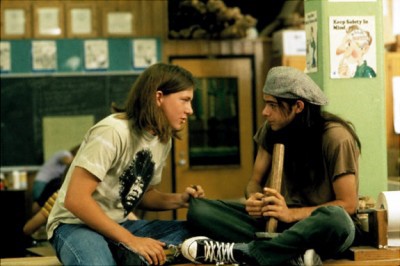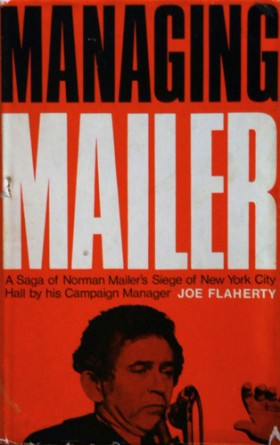Arnold Schwarzenegger So Far

Spawned by a stern former Nazi Sturmabteilunger who disliked him and believed that he was someone else’s son, Arnold Schwarzenegger spent years torturing his body into an exaggerated caricature. This expression of dysmorphia led him on a path to riches in America’s film industry, much as dysmorphic expressions of emaciation do for women. After accumulating tens of millions of dollars, it seemed a convenient parlay of attention and cash into running the whole state in which the film industry resided, and he announced his campaign for governor of California on the “Tonight Show with Jay Leno.”
To this day, no one knows how tall he is.
In 1986, two years after the release of The Terminator, he married Maria Owings Shriver, a niece of John F. Kennedy who was a “CBS Morning News” reporter at the time. (Of Schwarzenegger, the Times wrote that his “father was a policeman” in their brief wedding announcement.)
The two were introduced by Tom Brokaw. She retired from her career while he was in office, to avoid the appearance of a conflict of interest, and surely influenced his slow drift leftward throughout his two terms of as governor. When Schwarzenegger took office, not long after six women came forward to complain about unwanted touching, he immediately began accumulating debt on behalf of the state. As his term went on, he most often commuted to Sacramento from Brentwood in his Gulfstream.
In 2009, the state faced a nearly $25 billion budget gap. When he left office at the end of last year, the state of California had nearly $78 billion in outstanding bonds, and its debt payments are now more than $6 billion a year. Now, with California under new management that is currently attempting to close a $15 billion budget shortfall, Schwarzenegger’s marriage is ending.
The former governor is currently committed to three film productions. He is 63.
Australians Terrified By Man's Spiky Hair
To Prison Island, where an Australian rules football player was recently removed from the field “’because his hair was too dangerous’ and might have poked another player in the eye.” Nathan Van Someren was sent off during the third quarter after an umpire decided that his gelled mohawk represented too much of a threat to other players.
Which Would You Choose? Three Theoreticals

1. Would you rather die right now, painlessly, or live another 30 years with an increasingly debilitating ailment, with the last 10 years of your life spent entirely bedridden and in extreme physical pain?
On The One Hand:
You won’t have to experience the physical pain, which — as anyone who’s been in pain before can attest to — sucks. You also don’t have to experience the mental anguish that comes with growing old, i.e., friends dying; relationships ending; the realization creeping upon you that you can’t trust anyone or anything; the inevitable mark in time when you understand that the time you spent advancing your career goals was only a glorified diversion from contemplating your own impending nonexistence; the witnessing of sad events like, say, just off the top of my head here, your long-senile grandfather attending the funeral of his wife of 60 years and the sight of her in the casket hitting a deep-buried part of his brain so hard that it takes him out of his decades-long stupor for a moment of brief, horrific clarity during which he shouts her name in a way that leaves not a single family member in attendance without tears streaming down their faces; and TV shows like Carnivale getting prematurely cancelled.
On The Other:
The end result is the same no matter which choice (i.e., you being dead), so you may as well experience all life has to offer, even if that includes decades of terrible pain. Every experience, painful or otherwise, is a net positive simply because it is an experience. We’re working with a binary system here. Even if you believe in a spiritual plane of existence beyond this one, that’s not going anywhere. And, hell, it’ll even give you something to talk about with the other ethereals during the “How’d you get that emotional scar?” parlor game. And if you don’t believe in the next level of reality, then at the very least you get another 30 years with your memories versus, you know, having absolutely no more time with them. This is a consideration that should not be taken lightly.
2. Would you have sex with [ugliest celebrity of the gender to which you are not attracted] in order to have sex with [hottest celebrity of the gender to which you are attracted], keeping in mind, people will find out about the latter right away, but in one year’s time they’ll find out about the former?
On The One Hand:
You get to have sex with [hottest celebrity of the gender to which you are attracted], which is a pretty great deal in and of itself. That’s an amazing, what, 40–45 minutes? But the key is that after the news is released — either by a tabloid journalist or Mr./Ms. Celebrity confirming the rumor themselves, the point being, you’re not just going around and shouting from the rooftops about your sexual conquest, because that’d make you an ass — you get a year’s worth of unbridled jealousy from your friends/colleagues for having, what appears to be, a pretty amazing life.
On The Other:
Once the year is up and everyone knows you also had sex with [ugliest celebrity of the gender to which you are not attracted] and, in fact, that it was part of the deal in order to have sex with [hottest celebrity in the gender to which you are attracted], you will have to deal with so much shit. You will be mocked by friends/colleagues/strangers for the rest of your life. That said, after a few years, most people will forget this happened, and you’ll get to live your life normally. But whenever people truly wanted to hurt your feelings and couldn’t come up with a better insult, they’d always have this in their back pocket. And also, I mean, you’d have to physically have sex with this person who, again, is extremely unattractive and of a gender with which you are not used to having sex. But maybe it would open up a range of physical experiences you weren’t previously aware you enjoyed?
3. Inside your DNA contains the cure for every form of cancer. However, doctors cannot retrieve it until you are dead, and then it will take another 50 years to distill that into a usable vaccine. Do you kill yourself now or wait to die of natural causes?
On The One Hand:
Killing yourself now — as long as you’re able to deal with the ethical consequences that come with it — will save millions of people’s lives. Unfortunately, seeing as the cure won’t be ready for 50 years after your death, it’s not going to save anyone you know who has cancer already. So, if you’re doing this for your great-aunt or whomever, that’s noble and all of you, but it’s not really going to matter. Your payment, therefore, is a prominent place in the annals of history as The Person Who Cured Cancer. The fact that you chose to kill yourself to expedite this cure will only cause the posthumous statues of your likeness implanted around the globe to multiply dramatically.
On The Other:
You’re going to be saving a whole bunch of people’s lives, which is good, but come on, you’re going to be saving a bunch of people’s lives anyway when you’re dead. And either way it’s not going to be anyone close to you. So why waste the rest of your own life when the end result is basically the same? When we’re talking about the amount of people who are going to be cured of cancer in a 100-year span (the approximate 50 years you have left plus the 50 years for the doctors to work their magic) versus the rest of the timeframe that humanity is existence, it’s not really that much of a difference. That said, by waiting, you do risk someone else coming along and having the cancer cure in their own DNA, or doctors figuring it out themselves, meaning your brigade of posthumous statues are gone. How much does that enter your consideration? Also, seeing as how everyone knows you have to die to cure cancer, you’ll probably have to spend the rest of your days ducking a whole lot of assassination attempts. That won’t be fun.
Rick Paulas is a writer living in Los Angeles.
Who are the Three bin Laden Wives?

It’s hard to keep track of bin Laden’s wives, so we’re in need of a womens’ magazine to get with them all and ask them about their taste in shoes. Let’s see!
Najwa Ghanem left him after 9/11, after giving birth to 11 of his 20 children; then came Khadijah Sharif, who was smart and older, and she dumped him in the 90s (yes, you read that timeline right — the marriages were willy-nilly); and then Khairiah Sabar, who may be dead; and Siham Sabar is also out of sight or missing; and there’s Amal al-Sadah (or Amal Ahmed Abdullfattah) the fifth wife, who’s Yemeni, and still just 27, and was the alleged “human shield.” So there’s three accounted for — and there’s “three widows” in custody. But which ones? Here’s a handy guide; here’s another. Maybe this will all make sense someday?
Jews Make Woman Disappear
Here’s a verison of that now famous Situation Room picture for those of you who are frightened that it might turn you on. “The Hasidic newspaper will not intentionally include any images of women in the paper because it could be considered sexually suggestive.”
'The Baffler' Returns
Good news for those of you who were worried that there might never be another issue of The Baffler again: There will be! This fall! Awl pal Chris Lehmann remains on board! Well, I’m excited at least.
Pronoun(ced) Disaster! Justin Bond Furious Over 'NY' Mag Profile

Justin Bond promised some time ago that V would be very pissed at anyone who referred to V with a gendered pronoun, and so, understandably, V is really unhappy at today’s New York magazine profile. (Facebook samplings: “ugly, transphobic hit piece” and “Wow! I can’t even begin to find words about how offensive the Carl Swanson piece in NY Magazine turned out to be. I had him in my house — time to bring out the bleach.”) I mean, Wikipedia can deal with the pronouns; why couldn’t a gay writer at a magazine helmed by a gay? (That being said, I’m pretty sure the writer is stunned to see the reaction, and I’m totally sure he believes this is a supportive, informative, attentive magazine profile. And yet.)
More importantly: you know, can someone buy Justin some health insurance? Thanks.
Don't Dig Holes On Florida Beaches And Jump Into Them
“”It was like a crater. He was just digging in the sand, and was quite good at it. When we got the call we had no idea this person was buried up to his chin. He’d jumped into the hole and the walls around him collapsed, so there was a great deal of weight on his body. The fear was the walls would collapse again. We have very heavy, coarse sand in south-east Florida, it was a dangerous situation.”
— Sandra King of the Pompano Beach fire department tells the take of Jakub Maly, a 19-year-old swimmer with the Austrian Olympic team, who dug a big hole on the beach to impress his friends, only to have it collapse around him when he jumped in. Maly was rescued without major injuries.
The Strange, Great History Of Norman Mailer's $2.5 Million Penthouse
by Evan Hughes

The bad boys who gave much of 20th century American literature its “muscular, glamorous aura,” as one of their daughters, Alexandra Styron, puts it, are beginning to fade from view. So it’s worth sitting up to take note of the fact that the Brooklyn lair of the one you might call the lion king, Norman Mailer, is up for sale. Following the death of his widow, Norris Church Mailer, the nine Mailer children are listing the top-floor apartment at 142 Columbia Heights for $2.5 million. The broker, Dolores Grant of Corcoran, tells the Times that the place does not lend itself to easy comparisons, and perhaps she speaks more truth than she knows.
The killer slideshow accompanying a Times article from last week shows the apartment to be a splendid find for the literary house-hunter, at least in its furnished and book-lined state. But it also appears to be smaller than it has looked in my mind’s eye since I began researching the great enfant terrible for a book on literary Brooklyn.
Domestic drama and unlikely occurrences tended to follow Mailer around, so a lot of wonderfully odd events transpired in that space, including, I’m sure, some that we’ll never hear about. Mailer bought the building with his mother in 1960 and moved in two years later. The delay no doubt had something to do with the fact that in the interim Mailer stabbed his then wife, Adele, at their own Manhattan party, which made things a bit rocky for the both of them. (In her terrific biography Mailer, Mary Dearborn provides a gripping account of the incident, opening with a line from Beat poet Michael McClure: “1959–60 was a great year to fall apart.”)
In 1962, Mailer (who grew up in the Brooklyn neighborhoods of Flatbush and Crown Heights) moved to the elegant house in the Heights with wife number three, Lady Jeanne Campbell. They soon undertook the substantial and inventive renovation that made the apartment the light-filled curiosity you see in the slideshow. Mailer wanted his writing space to be way up near the ceiling and had a carpenter friend build a loft up there. To reach this perch, you had to get to a crow’s nest that led to a catwalk and then to a rope ladder — very pirate-on-the-high-seas. At parties, Mailer liked to challenge his guests to make the ascent. (I like to picture him giving them a big knife that must be held between the teeth, but I’m making that part up.)

The renovation and rope-ladder contraption were in keeping with Mailer’s interest in building and tinkering; he left Harvard with a degree in engineering. A few years after moving in, Mailer began spending an inordinate amount of time building, in the middle of the living room, a huge imaginary model city made out of Legos. He announced the project in major magazines, underlining his complete seriousness in taking on the ills of modern urban life through imaginative, vertically oriented architecture. At some point the Museum of Modern Art wanted to display the model city, but it was discovered, after talk of a crane-lift, that the thing could not be removed without disassembly, and for Mailer this was a nonstarter. The model, which Dearborn says took up a third of the available floor space in the room, stood there for around five decades.
In 1965 the author threw a party in honor of the new light heavyweight champion of the world, José Torres. Mailer had bet heavily on Torres in the title bout, held in New York, and had planned the fight-night party in advance, and sure enough Torres came through with the victory over Willie Pastrano. (After the 8th round, the referee checked Pastrano’s condition by asking him who and where he was. He replied, “I’m Willie Pastrano and I’m at Madison Square Garden getting the shit kicked out of me.”) Torres joined the boisterous soirée at Mailer’s place, got unusually drunk, went home and passed out (long day), and returned in the morning to find the party still in full swing.

Mailer also convened a merry meeting at the apartment in 1969 to discuss the idea of a run for mayor. To get both attention and advice, he invited some media types, including Pete Hamill, Peter Maas, and Gloria Steinem, who was apparently undeterred by Mailer’s reputation for misogyny. Joe Flaherty of the Village Voice was also in attendance and later wrote, in a curious sentence, “The warmth of the room appealed to my Irish heart; it seemed like a blend of wood and whiskey, combining the best aspects of the womb and the coffin.” Two hours of drinking preceded the actual meeting. Mailer stood at the head of the room, waving around a tall bourbon “like an ever present hand puppet,” in Flaherty’s words. Jimmy Breslin was there, doling out straight talk, and the group agreed that he should join the Mailer ticket, which he did. (Flaherty became the campaign manager and then wrote the book Managing Mailer, which Mailer blurbed by paying the compliment that he wished it didn’t exist.)
After the meeting, Flaherty and a small group parted ways with Breslin outside and then heard his raucous laughter down the block. Breslin stood on the sidewalk, cupped his hands around his mouth, and bellowed at everyone and no one, “Do you know something? That fuckin’ bum is serious!” And in fact Mailer became a tireless candidate, if an atypical one. During the campaign, Mailer was interrupted in the middle of a soliloquy about the departed Brooklyn Dodgers by a young man who brought up the snowstorm that had seriously damaged Mayor John Lindsay’s reputation when the streets were not cleared for days: “What would you have done about the snow in Queens?” The correct answer to this question was obvious, but Mailer gave a different one. “I’d piss on it,” he roared.
In 1976, the apartment on Columbia Heights, now shared by Norris Church, served as the venue for an anniversary party for Doris Kearns and Dick Goodwin. Attendees included Jackie Onassis, Bob Dylan, Woody Allen, Joni Mitchell, Kurt Vonnegut, Ali MacGraw, a senator or two, and Hunter S. Thompson, who overstayed his welcome. (The list goes on from there, and as I look at the Times slideshow I keep wondering how everyone fit, what with all the Legos.) Christian Lorentzen in the New York Observer:
Hunter Thompson, among the last to leave, came back and rang the doorbell at 6 a.m., asking for bacon and eggs, which [Norris Church] duly served up. Mr. Thompson crashed in a hammock in the Mailer living room, flipping out of it at 3 p.m. Sunday afternoon. “Thanks for a great party, Norris,” he said on his way out.
Mailer was not yet married to Norris at this point; in fact, he was married to Beverly Bentley Mailer, who had exchanged vows with him in this very apartment in 1963. In the fall of 1980, he finally got an acrimonious and costly divorce from Beverly. The financial fallout meant that he had to sell off the lower floors of the Heights building so he could buy back his house in Provincetown, MA, which had been auctioned off. (Long story.) Mailer now wanted to marry Norris. Problem was, he had had a child with another mistress, Carol Stevens, and he wanted to man up, as it were, and give the daughter “legitimacy.” For him, the solution was clear: he married Carol on a Friday at 5 p.m., flew to Haiti two hours later to secure the divorce, returned the next day, and married Norris three days later in, where else, the living room on Columbia Heights. Liz Smith scored the scoop on this story, which got widespread attention and produced the headline “TRIGAMIST!” Norman and Norris left the reception while it was still crowded with A-listers so they could fly to London, where Mailer had a bit part in Milos Forman’s film Ragtime.
One of Mailer’s Brooklyn guests the following year had a particularly eyebrow-raising past. Jack Henry Abbott began corresponding with Mailer from prison in 1978. He was serving 20 years for murder and had heard of Mailer’s interest in the Gary Gilmore case, which the author eventually documented in The Executioner’s Song. Mailer helped Abbott, a self-made intellectual, to publish some of his letters in The New York Review of Books and then land a book deal. He came up for parole in 1981. In a plausible reading of his correspondence, he himself had warned that releasing him was a poor idea. But he was approved for parole, presumably in part because Mailer had extended him a job offer as an assistant upon release.
Mailer met Abbott’s plane at JFK late at night on the day he was released, and the two went back to Mailer’s place to have a celebratory drink on the terrace. A month later, Abbott killed a young waiter in the East Village with a knife through the heart. In an incredible irony and journalistic embarrassment, this stabbing, based on a petty misunderstanding, occurred the day before Abbott’s book received a prominent favorable review in The New York Times Book Review, which had already been printed. When the paper landed on stoops, the author was a repeat murderer on the lam, and he was not caught until months later, in New Orleans. Mailer did not handle the media firestorm well, conceding only when backed into a corner by criticism, “I have blood on my hands.”
It was around this time that Mailer came under federal investigation in connection with a large-scale smuggling ring that ran hashish into the country by sea. Mailer knew several of the key players, and a number of them were eventually arrested. It appears that during the years-long investigation, the authorities were targeting Mailer, a big-name fish. “The feds were into star-fucking,” the fallen kingpin, Richard Stratton, told Dearborn decades later. (Good get, Ms. Dearborn.) At some point Mailer’s place was broken into and ransacked, and it looked like the work of law enforcement. Nothing was reported stolen, but a bag of Mailer’s pot was placed in the center of his bed.
Stratton also told Dearborn that he had once stood with Mailer on the Brooklyn Heights promenade just outside Mailer’s apartment and described to the writer how a huge shipment had come into the Brooklyn docks just below them. But no one has been able to determine Mailer’s role in the drug ring, if he had any. His friend Buzz Farbar (who had been at that mayoral planning session years before) got arrested and agreed to wear a wire over lunch with Mailer at Armando’s, a restaurant still in operation on Montague Street in Brooklyn Heights. Mailer said nothing to incriminate himself and he never faced any consequences. Instead he went on writing and living part-time at the Columbia Heights penthouse until his death, at 84, in 2007. Someone suitably outrageous ought to buy the place.
Evan Hughes’s book, Literary Brooklyn, a work of literary biography and urban history, will be published in August by Henry Holt. He’s on twitter.
Photo by Dominique Nabokov. Used with permission.
